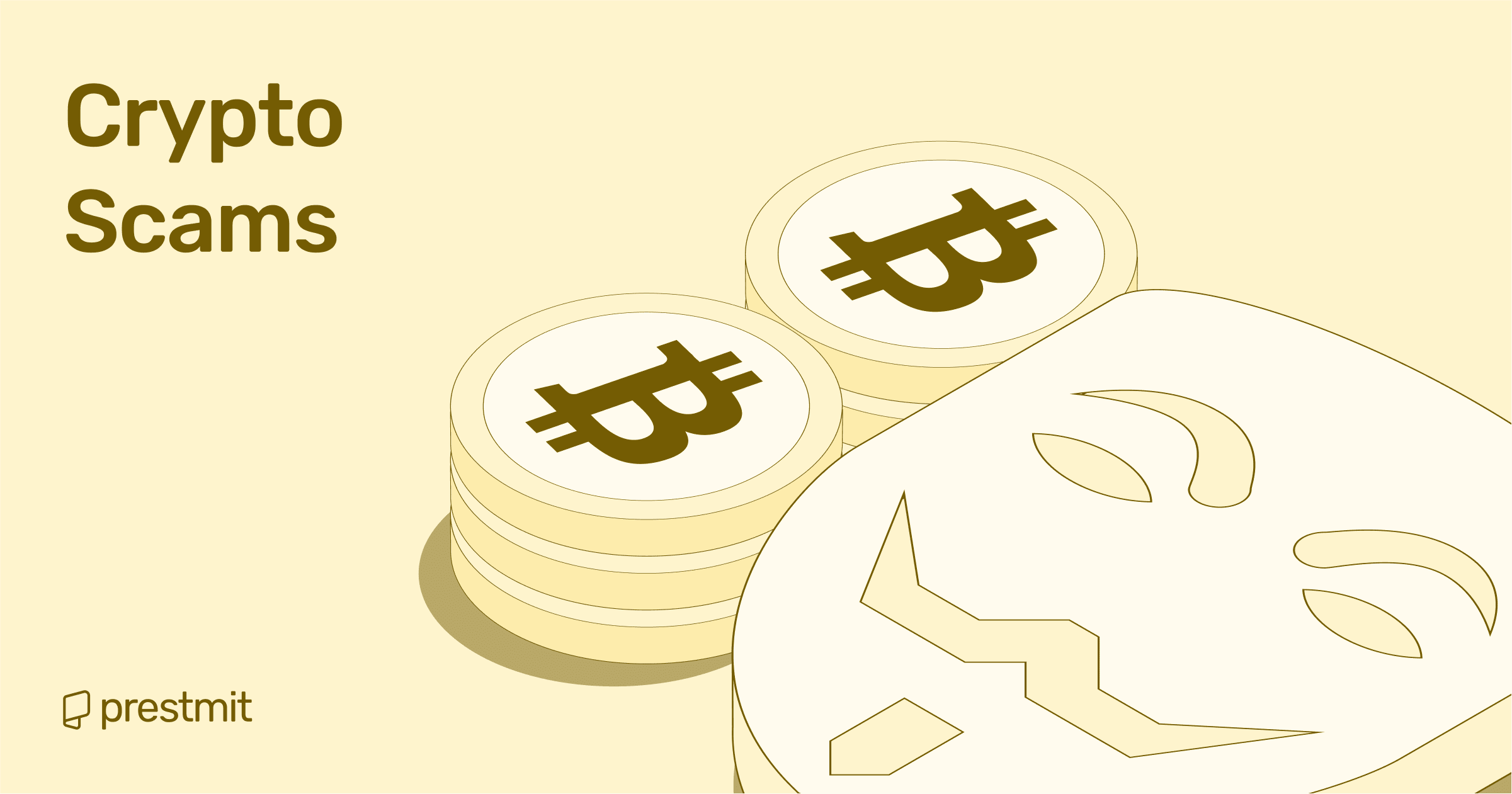Table of Contents
Over 580 million people now own cryptocurrency worldwide, which is expected to reach 1 billion by the end of 2025. More than 7% of the global population is diving into crypto, and wherever there is hype, there is always a scammer waiting to pounce.
Scammers want returns, too, and they’ve leveled up. We’re talking AI-generated deepfakes, lookalike websites, and emotional sob stories designed to make you open your wallet. According to the FBI’s 2024 report, crypto scams cost investors over $4.6 billion in 2024, which is still climbing.
This guide explains crypto scams, how to identify them, and how to avoid falling victim, because keeping your crypto is just as important as earning it.
What Are Crypto Scams?

A crypto scam is any scheme in which someone tricks you into handing over your crypto, wallet keys, or sensitive information with promises of massive returns or fake investment opportunities.
In simple terms: Imagine walking into a street market with a bag of cash. There are real vendors selling useful stuff, but pickpockets, fake stalls, and smooth-talkers offer deals that sound too good to be true. You might leave richer, or you might leave broke.
Crypto scams work the same way. Except the market is online and open 24/7, and once your crypto is gone, you’re not getting it back.
How Can You Identify Crypto Scams?
Spotting a crypto scam isn’t always easy, when fraudsters use AI tools, deepfakes, and fake support chats. But most scams still use the same format. Here’s how you can sniff them out:
1. Pump and Dump Schemes
A pump and dump scheme happens when a group hypes up a worthless coin to send the price skyrocketing, then secretly sells their stash while unsuspecting investors are still buying.
How to Identify It:
- Sudden social media hype from influencers or Telegram groups about a coin you’ve never heard of.
- A coin with no working product, use case, or partnerships, yet its price is skyrocketing.
- The project sounds too focused on price and community, not on actual tech.
2. Fake Crypto Websites & Phishing Scams
Scammers create lookalike websites or send phishing messages to steal your wallet keys, login info, or funds. Sometimes they don’t even need a full site, a fake wallet prompt or link can drain your crypto.
How to Identify It:
- URLs that look almost right but are not (e.g., binanse.com instead of binance.com).
- Lack of HTTPS (no padlock icon).
- Websites with grammar mistakes, weird fonts, or broken pages.
- Emails or DMs with generic greetings like “Dear user” or “Hello valued customer.”
- Random prompts to connect your wallet out of nowhere.
3. Crypto Ponzi Schemes
These are classic pyramid schemes wearing crypto clothes, where early investors are paid with money from new investors, until the whole thing collapses.
How to Identify It:
- No one can promise guaranteed returns. Crypto is risky by nature, so no one can promise profits.
- The project talks more about referral bonuses and recruitment than actual blockchain use.
- There’s no real product, no working prototype, and no transparency.
Real Example:
BitConnect promised 1% daily returns before collapsing in 2018, costing investors over $2.5 billion.
Unfortunately, BitConnect wasn’t the first and won’t be the last. For more real-world cases, check out this list of major Bitcoin Ponzi schemes.
4. Fake Airdrops & Giveaways
The old giveaway scam by fraudsters who sometimes disguise themselves as celebrities or influencers is still alive and thriving in 2025. It goes like this: “If you send us 0.1 ETH, we’ll send you back 1 ETH.” The only difference is that it is more advanced now. Latest version uses AI-generated graphics and slick promo videos.
How to Identify It:
- The giveaway asks you to send crypto to activate your reward. Legit giveaways never work this way.
- The offer comes from suspicious social media accounts pretending to be Elon Musk, CZ, or other crypto figures.
- Poorly verified links or fake event pages are often shared in comment sections, DMs, or Telegram groups instead of official project sites.
5. Pig-Butchering Scams (Romance Fraud)
Romance scam involves scammers build relationships with you, usually over Telegram, dating apps, or social media, and then slowly convince you to invest in fake crypto platforms or shady opportunities. Sounds wild, but it’s real. In 2024, 33% of crypto scam losses came from romance-based fraud like this.
How to Identify It:
- Someone you barely know starts talking about crypto investments.
- They move the relationship fast, then suddenly mention a financial crisis or opportunity.
- They suggest you try it out by sending small amounts first, then ask for more over time.
- They share screenshots of profits from fake platforms to hook you in.
6. AI-Enhanced Scams
AI-enhanced scams involves scammers using AI-generated support chats, deepfake videos, and hyper-personalized phishing emails to sound more convincing than ever.
How to Identify It:
- Messages are too polished yet emotionally manipulative, urging you to act fast.
- Fake “support reps” may sound eerily real, but push you to send crypto or hand over private keys.
- Video or voice calls that glitch, lag, or give odd responses when you ask detailed or unexpected questions. If their lips don’t match the words, or it feels scripted, it might be AI, not a real person.
How Do You Avoid Crypto Scams?
1. Do Your Own Research (DYOR)
Before investing in any crypto project, verify the details yourself. Scammers rely on hype and laziness; don’t make it easy for them.
Here’s what to check:
- Does the team have real LinkedIn profiles, previous projects, or a verifiable history?
- Review the whitepaper: Does it explain a real solution, or is it just buzzwords?
- Check for audits: Reputable projects undergo security audits, usually listed on sites like Certik.
- Verify social channels: Is the project active on X (Twitter), Discord, or Telegram? Do they engage with their community?
- Use tools like CoinMarketCap or CoinGecko to cross-check listings and links.
2. Use Trusted Platforms
Stick to regulated exchanges and platforms with real customer service. In Nigeria, for example, consider Binance, Paxful, Prestmit, or other reputable sellers over random Telegram OTC sellers.
3. Protect Your Wallet
Think of your crypto wallet like your house keys. You wouldn’t hand them to a stranger, so don’t do it online. These tips will help you safeguard your crypto wallet from theft and fraud:
- Use hardware wallets or reputable software wallets with 2FA
- Never share your seed phrase
- Install browser extensions that block phishing sites and drainers
4. Stay Skeptical
Scammers thrive on trust and urgency. Even after you’ve done your research, stay cautious. If something feels too good to be true, it probably is.
Ask yourself:
- Why are they offering this to me?
- What’s in it for them?
- Am I being pressured to act fast?
- Would this offer sound ridiculous if it weren’t about crypto?
Frequently Asked Questions (FAQs) About Identifying Crypto Scams
How can I tell if a crypto project is legit or a scam?
You can know if a crypto project is legit or a scam by checking if the team is real and verifiable. Look for LinkedIn profiles or past projects. Make sure there’s an actual product, not just promises. Check reviews on Trustpilot or Reddit, and verify announcements on the project’s official website or social media.
What should I do if I fall for a crypto scam?
If you fall victim to a crypto scam, you can report it to your local financial crime unit. Blockchain forensics firms might be able to help.
Can I recover stolen crypto if I’ve been scammed?
Unfortunately, most crypto transactions are irreversible. But you should still report the scam to Chainabuse, your exchange, and local authorities. Some forensic firms can trace stolen crypto, but recovery is rare.
Is it still safe to invest in crypto?
Yes, it is safe to invest in crypto. But, you must stick to verified platforms, do your own research, and never invest money you can’t afford to lose. If you follow basic safety steps, you can still invest confidently.
Conclusion
Crypto is expected to be bigger than ever, and so will the risks. Scammers are getting smarter, faster, and more tech-savvy, but you can stay one step ahead.
Whether it’s AI-generated deepfakes, fake giveaways, romance scams, or phishing traps, the rules of staying safe haven’t changed: Pause. Breathe. Double-check.
Crypto isn’t a race; protecting your funds is more important than chasing quick wins.
Stick to trusted platforms, use secure wallets, and always do your research. When in doubt, remember it’s better to miss out on a deal than to lose your crypto to a scam.
Last updated on July 25, 2025

